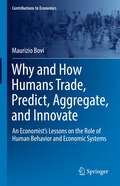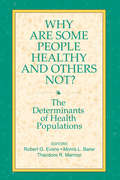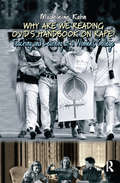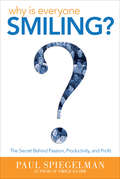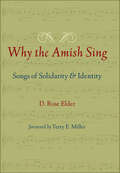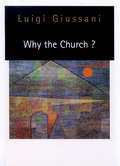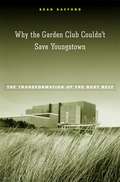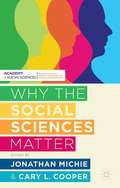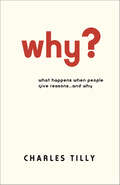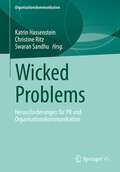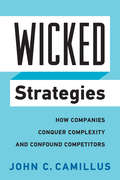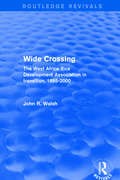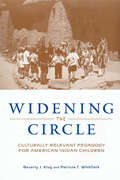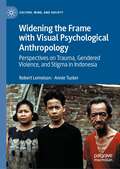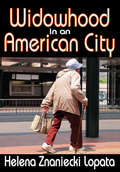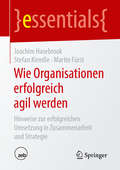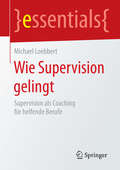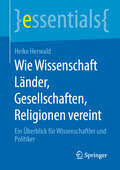- Table View
- List View
Why and How Humans Trade, Predict, Aggregate, and Innovate: An Economist’s Lessons on the Role of Human Behavior and Economic Systems (Contributions to Economics)
by Maurizio BoviTrading, forecasting, aggregating, and innovating (the Four) are key social interactions in human life at both the individual and aggregate levels. They are part of the human fabric because they stem from mankind’s peculiarities—heterogeneity, inclination to forecast, sociality, and inventiveness. But humans have multifaceted behavior, too. They are capable of having contradictory impulses towards one another, integrating and disintegrating as well as cooperating and dominating, and behaving prosocially and anti-socially. Hence, humans need to organize themselves in order to maintain, improve, and extend their social interactions as well as a safe and ordered life. Crucial intersections emerge naturally—the efficiency of humans’ way of tackling the Four is a joint product of economic systems, institutions, and behaviors. All told, the main idea of this book is to include in a single tour a collection of insights on why and how humans implement the Four. The narrative highlights several connections as well as how key these businesses are as the traveler is escorted through some Four-related behavioral problems and institutional solutions that humans have been, respectively, facing and elaborating over time. Economics students may exploit this book by both inserting what they are learning from textbooks into a wider framework and enjoying some of the hints revealed by the grand social theorizing of giants such as A. Smith and J. Schumpeter. But the proposed tour may also attract outsiders to economics who are curious about disparate economic themes linked to the Four but who wish to gain an overview without engaging in longer readings.
Why are Saving Rates of Urban Households in China Rising?
by Marcos Chamon Eswar PrasadA report from the International Monetary Fund.
Why are Some People Healthy and Others Not?: Determinants Of Health Of Populations (Social Institutions And Social Change Ser.)
by Morris L. Barer Theodore R. Marmor Robert G. EvansEach topical chapter in this volume crystallizes the findings of a five-year study, under the auspices of the Population Health Program of the Canadian Institute for Advanced Research, that probed the links between social hierarchy, the -macroenvironmental- factors in illness patterns, the quality of the -microenvironmental, - and other determinants of health. In its aggregate, this volume will prove essential to an understanding of the underlying public health issues for the next several decades.
Why are We Reading Ovid's Handbook on Rape?: Teaching and Learning at a Women's College
by Madeleine KahnWhy Are We Reading Ovid's Handbook on Rape? raises feminist issues in a way that reminds people why they matter. We eavesdrop on the vivid student characters in their hilarious, frustrating, and thought-provoking efforts to create strong and flexible selves against the background of representations of women in contemporary and classical Western literature. Young women working together in a group make surprising choices about what to learn, and how to go about learning it. Along the way they pose some provocative questions about how well traditional education serves women. Equally engaging is Kahn's own journey as she confronts questions that are fundamental to women, to teachers, to students and to parents: Why do we read? What can we teach? and What does gender have to do with it?
Why is Everyone Smiling?: The Secret Behind Passion, Productivity, and Profit (Why Is Everyone Smiling? Ser.)
by Paul SpiegelmanA call center company CEO shares how businesses of all sizes can repeat his success by focusing on employee loyalty—and not outsourcing. How many small businesses have a full-time coworker whose official title is &“Queen of Fun and Laughter?&” How many have a CEO and COO who dress in matador outfits for a company holiday video version of Dancing with the Stars? Beryl is a &“Top Small Workplace&” because of one thing—its focus on people. Visitors report they feel the &“vibe&” when they walk in the door. As a call center company, a business normally known for high turnover, low morale, and a boiler room environment, Beryl created a special culture resulting in low attrition, high customer loyalty, and profits reinvested in coworkers. What Beryl does behind the scenes to take care of the needs of its internal family sets it apart. It operates with a real spirit of camaraderie; the loyalty of team members at every level; a leadership team that operates with a true servant mindset; and a CEO, Paul Spiegelman, who believes that everyone deserves a chance to feel important. He rewards people frequently, respects their efforts and opinions, and informs them of everything that impacts them.&“Paul drills right to the core of the solution…focusing on people, building a culture of customer satisfaction from the top down, and empowering employees to do the right thing. What really drives business is the human touch, and Paul has the touch.&” —James D. Power IV, Executive Vice President, J. D. Power and Associates, co-author of Satisfaction: How Every Great Company Listens to the Voice of the Customer
Why the Amish Sing: Songs of Solidarity and Identity (Young Center Books in Anabaptist and Pietist Studies)
by D. Rose ElderAn intimate portrait of the diverse music-making at the center of Amish faith and life.Singing occurs in nearly every setting of Amish life. It is a sanctioned pleasure that frames all Amish rituals and one that enlivens and sanctifies both routine and special events, from household chores, road trips by buggy, and family prayer to baptisms, youth group gatherings, weddings, and "single girl" sings. But because Amish worship is performed in private homes instead of public churches, few outsiders get the chance to hear Amish people sing. Amish music also remains largely unexplored in the field of ethnomusicology. In Why the Amish Sing, D. Rose Elder introduces readers to the ways that Amish music both reinforces and advances spiritual life, delving deep into the Ausbund, the oldest hymnal in continuous use. This illuminating ethnomusicological study demonstrates how Amish groups in Wayne and Holmes Counties, Ohio—the largest concentration of Amish in the world—sing to praise God and, at the same time, remind themselves of their 450-year history of devotion. Singing instructs Amish children in community ways and unites the group through common participation. As they sing in unison to the weighty words of their ancestors, the Amish confirm their love and support for the community. Their singing delineates their common journey—a journey that demands separation from the world and yielding to God's will.By making school visits, attending worship services and youth sings, and visiting private homes, Elder has been given the rare opportunity to listen to Amish singing in its natural social and familial context. She combines one-on-one interviews with detailed observations of how song provides a window into Amish cultural beliefs, values, and norms.
Why the Church?
by Luigi GiussaniGiussani begins by focusing on the Church as a community composed of people who are aware of themselves as defined by the gift of the Spirit, from which they derive a new conception of existence, the fruit of conversion. He then describes the Church's developing self-awareness of its dual elements of the human and divine. Concerned with verifying the Church's claim to embody Christ, Giussani situates the locus of verification in human experience, arguing that a different type of life is born in those who try to live the life of the Church. Why the Church? is a seminal study that will engage both the scholar and the general reader.
Why the Church?
by Luigi GiussaniGiussani begins by focusing on the Church as a community composed of people who are aware of themselves as defined by the gift of the Spirit, from which they derive a new conception of existence, the fruit of conversion. He then describes the Church's developing self-awareness of its dual elements of the human and divine. Concerned with verifying the Church's claim to embody Christ, Giussani situates the locus of verification in human experience, arguing that a different type of life is born in those who try to live the life of the Church. Why the Church? is a seminal study that will engage both the scholar and the general reader.
Why the Garden Club Couldn't Save Youngstown: The Transformation of the Rust Belt
by Sean SaffordIn this book, Sean Safford compares the recent history of Allentown, Pennsylvania, with that of Youngstown, Ohio. Allentown has seen a noticeable rebound over the course of the past twenty years. Facing a collapse of its steel-making firms, its economy has reinvented itself by transforming existing companies, building an entrepreneurial sector, and attracting inward investment. Youngstown was similar to Allentown in its industrial history, the composition of its labor force, and other important variables, and yet instead of adapting in the face of acute economic crisis, it fell into a mean race to the bottom. Challenging various theoretical perspectives on regional socioeconomic change, Why the Garden Club Couldn’t Save Youngstown argues that the structure of social networks among the cities’ economic, political, and civic leaders account for the divergent trajectories of post-industrial regions. It offers a probing historical explanation for the decline, fall, and unlikely rejuvenation of the Rust Belt. Emphasizing the power of social networks to shape action, determine access to and control over information and resources, define the contexts in which problems are viewed, and enable collective action in the face of externally generated crises, this book points toward present-day policy prescriptions for the ongoing plight of mature industrial regions in the U.S. and abroad.
Why the Social Sciences Matter
by Cary L. Cooper Jonathan MichieToday's society is on the brink of new possibilities, yet it is also beset with challenges and problems. Banks are in trouble. Climate change threatens. The population is increasingly elderly. New health technologies pose new ethical questions. Globalization has changed the way we live. Public issues and private troubles are as interlaced as ever. And, big or small, problems need solutions based on accurate and suitable information, and on a proper understanding of the issues involved. This volume, consisting of specially-commissioned essays on topics of prime concern by leading social scientists at the cutting-edge of their respective research fields, takes a considered look at a range of problems facing society today, and considers possible solutions. It illuminates why a social scientific understanding gives us a grasp on a topic that would not be provided by those working in the fields of science, humanities or the arts; in other words, this book makes plain what is distinctive and thus invaluable about a social science perspective. Social scientists may be forgiven for being troubled by UK trends in funding undergraduate training and the 'impact' agenda in research. This volume, with the support of the Academy of Social Sciences, is timely in not only analysing pressing problems, but also helping make the case regarding the indispensability of the social sciences, and the rigour which the social sciences can inspire in our understanding of the world.
Why?: What Happens When People Give Reasons . . . and Why
by Charles TillyWhy? is a book about the explanations we give and how we give them--a fascinating look at the way the reasons we offer every day are dictated by, and help constitute, social relationships. Written in an easy-to-read style by distinguished social historian Charles Tilly, the book explores the manner in which people claim, establish, negotiate, repair, rework, or terminate relations with others through the reasons they give. Tilly examines a number of different types of reason giving. For example, he shows how an air traffic controller would explain the near miss of two aircraft in several different ways, depending upon the intended audience: for an acquaintance at a cocktail party, he might shrug it off by saying "This happens all the time," or offer a chatty, colloquial rendition of what transpired; for a colleague at work, he would venture a longer, more technical explanation, and for a formal report for his division head he would provide an exhaustive, detailed account. Tilly demonstrates that reasons fall into four different categories:Convention: "I'm sorry I spilled my coffee; I'm such a klutz." Narratives: "My friend betrayed me because she was jealous of my sister." Technical cause-effect accounts: "A short circuit in the ignition system caused the engine rotors to fail." Codes or workplace jargon: "We can't turn over the records. We're bound by statute 369." Tilly illustrates his topic by showing how a variety of people gave reasons for the 9/11 attacks. He also demonstrates how those who work with one sort of reason frequently convert it into another sort. For example, a doctor might understand an illness using the technical language of biochemistry, but explain it to his patient, who knows nothing of biochemistry, by using conventions and stories. Replete with sparkling anecdotes about everyday social experiences (including the author's own), Why? makes the case for stories as one of the great human inventions.
Wicked Problems: Herausforderungen für PR und Organisationskommunikation (Organisationskommunikation)
by Katrin Hassenstein Swaran Sandhu Christine RitzPR und Organisationskommunikation müssen zunehmend wicked problems, also verzwickte Probleme, lösen. Ob Digitalisierung, Künstliche Intelligenz oder andere aktuelle Entwicklungen, sie stellen die PR und Organisationskommunikation vor knifflige oder verzwickte Probleme: Für diese kann es keine einfachen Lösungen geben, weil sie sich dynamisch entwickeln und nicht zentral geregelt werden können. Die Beiträge zeigen dies aus unterschiedlichen Perspektiven auf und stellen sich den Herausforderungen von wicked problems auf Mikro-, Meso- und Makroebene sowie auf einer Querschnittsebene.
Wicked Strategies: How Companies Conquer Complexity and Confound Competitors
by John C. CamillusIn business, some problems are so complex, intractable and threatening to organizations--or entire industries--that they are best described as "wicked." These problems appear to be unsolvable and they render traditional analytical tools of strategy virtually impotent.Wicked Strategies offers a comprehensive framework for identifying, responding to and profiting from wicked problems. John C. Camillus, drawing on detailed, real-life examples from companies across the globe, has skillfully woven together the analytical techniques, processes and organizational designs that will enable managers to navigate a disruptive marketplace. His feed-forward framework for fashioning wicked strategies empowers firms to presciently transform their business models before they are made obsolete by the competition. Wicked Strategies is a practical and evocative guide that demonstrates how business leaders can profitably capitalize on unknowable futures.
Wicked Women of Tudor England
by Retha M. WarnickeThis fascinating study delves into the lives of six Tudor women celebrated for their reputed wickedness. Collected here are accounts of Anne Boleyn, Katherine Howard, Anne Seymour, Lettice Dudley, and Jane and Alice More. Warnicke rescues these women from historical misrepresentations and helps us to rediscover the complex world of Tudor society.
Wide Crossing: The West Africa Rice Development Association in Transition, 1985-2000
by John R. WalshThis title was first published in 2001. The West Africa Rice Development Association (WARDA) was established in the early 1970s to help farmers increase rice production. Africa is the only continent whose population has grown faster than its food production; this shortfall provokes the syndrome of poverty, hunger and violence there. WARDA first attempted to alleviate the food deficit by introducing high-yielding imported crop varieties. This strategy drove green revolution in Asia and Latin America but failed in Africa. This book recounts WARDA's revival after nearly succumbing in the 1980s. Not only did the programme have to deal with a harsh agricultural environment, but also with severe economic, political and social constraints. WARDA made crucial advances in rice research and also coped successfully with non-scientific challenges. WARDA serves as a thriving example of a combined international research center and a regional organization.
Widening the Circle: Culturally Relevant Pedagogy for American Indian Children
by Beverly J. Klug Patricia T. WhitfieldRecognizing the need for a pedagogy that better serves American Indian students, Beverly J. Klug and Patricia T. Whitfield construct a pedagogical model that blends native and non-native worldviews and methods. Among the building blocks of this new, culturally relevant education are language-based approaches to literacy development, the use of oral histories to supplement traditional texts, and a re-evaluation of the knowledge base these students need for success in tribal enterprises.
Widening the Frame with Visual Psychological Anthropology: Perspectives on Trauma, Gendered Violence, and Stigma in Indonesia (Culture, Mind, and Society)
by Annie Tucker Robert LemelsonThis book uses visual psychological anthropology to explore trauma, gendered violence, and stigma through a discussion of three ethnographic films set in Indonesia: 40 Years of Silence (Lemelson 2009), Bitter Honey (Lemelson 2015), and Standing on the Edge of a Thorn (Lemelson 2012). This exploration “widens the frame” in two senses. First, it offers an integrative analysis that connects the discrete topics and theoretical concerns of each film to crosscutting themes in Indonesian history, society, and culture. Additionally, it sheds light on all that falls outside the literal frame of the screen, including the films’ origins; psychocultural and interpersonal dynamics and constraints of deep, ongoing collaborations in the field; narrative and emotional orientations toward editing; participants’ relationship to their screened image; the life of the films after release; and the ethics of each stage of filmmaking. In doing so, the authors widen the frame for psychological anthropology as well, advocating for film as a crucial point of engagement for academic audiences and for translational purposes.Rich with critical insights and reflections on ethnographic filmmaking, this book will appeal to both scholars and students of visual anthropology, psychological anthropology, and ethnographic methods. It also serves as an engrossing companion to three contemporary ethnographic films.
Widerstand in Organisationen • Organisationen im Widerstand - Revisited: Plattformen, Edupunks und die Free Crowd (Organisation und Gesellschaft)
by Ayad Al-AniDie hier vorgestellten Alternativen zur traditionellen Hierarchie, die Anfang des Jahrtausends zum ersten Mal die Bühne betraten und zunächst in der Open-Source-Bewegung und dann auf kommerziellen Crowdplattformen ihren Siegeszug antraten, haben sich im Laufe kurzer Zeit verändert. Konnte man Anfang des Jahrtausends noch hoffen, dass ein Wirtschaftssektor entsteht, der hierarchieärmer, ethischer und partizipativer ist, so musste man nach der Finanzkrise feststellen, dass derartige Organisationsformen oft Teil eines pulsierenden Kapitalismus waren, welcher auch fremdartige Konzepte sporadisch nutzt, um auf Krisen zu reagieren. Auch von der Idee, dass die Digitalisierung die Demokratie beflügeln könnte, ist wenig übriggeblieben. Allerdings haben die nun entstandenen technologischen Plattformen einen massiven Nebeneffekt. Die hier gesammelten Daten gaben der Automatisierung einen neuen Schub. Die Flucht aus der Hierarchie, die in den ersten beiden Ausgaben skizziert wurde, wird also weiter gehen. Es sind nun die Konturen technologiebasierter Communities erkennbar, welche Heimat einer „Freien Crowd“ sind und ergänzend zu den bestehenden Nationen mehr Gewicht erlangen können.
Widowhood in an American City
by Helena LopataWidowhood in an American City focuses on the roles and lifestyles of urban American widows fifty years of age or older. These women form a segment of two generations of one society; they present a historical instance of people born and brought up under conditions that are not likely to be duplicated. Not only the U.S., but many other countries are undergoing modifications in the degrees and forms of urbanization, industrialization, and social complexity.Helena Znaniecki Lopata argues that the way women re-engage society following the death of a husband is different due to their location in the modern social system. She notes that the trends in social structure are toward increasingly voluntaristic engagement in achieved, functionally oriented social roles that are performed in large groups and contain secondary social relations. The cultural background of many societal members prevents the utilization of most resources of the complex urban world, restricting them to a small social life space, with almost automatically prescribed social relations.Those who argue that the elderly are socially isolated contend that this is a result of the natural process of withdrawal of the person and the society from each other. These arguments focus on those who are isolated or lonely and those who lack the skills, money, health, and transportation for engaging or re-engaging society. Lopata's study indicates that this assumption is false for many widows. If such people are to be helped, a fresh view of the relation between the urban, industrial, and complex modern world and its residents is required, and new action programs must be creatively developed. This is a timely, ground-breaking work that addresses and shatters common myths associated with growing old alone in an urban society.
Widows: North America
by Helena Znaniecka LopataThe volume examines two communities in Canada, a Florida retirement community, and communities in Ohio, Nebraska, and California, as well as the relative situations of homeowners, blacks, and poor ethnic populations.
Widows: The Middle East, Asia, and the Pacific
by Helena Znaniecka LopataThis volume analyzes the support systems and lifestyles of widows in Australia, the Philippines, Korea, Iran, China, India, Turkey, and Israel.
Wie Organisationen erfolgreich agil werden: Hinweise zur erfolgreichen Umsetzung in Zusammenarbeit und Strategie (essentials)
by Joachim Hasebrook Stefan Kirmße Martin FürstViele Unternehmen haben agile Methoden in ihren Arbeitsalltag integriert. Oft stellen sie fest, dass neue Ideen und Entwicklungsvorsprünge durch agile Arbeit von starren Organisationsstrukturen, Ziel- und Anreizsystemen ausgebremst werden. Agilität funktioniert nur, wenn zur agilen Zusammenarbeit auch agile Organisationsstrukturen und agile Unternehmensstrategien hinzukommen. Auf der Basis eigener Forschung und umfangreicher Projekterfahrungen zeigen die Autoren, für welche Unternehmensbereiche und Aufgaben Agilität geeignet ist und für welche nicht, welcher nachweisbare Nutzen und welche Risiken durch Agilität entstehen und wie der Weg zur agilen Organisation erfolgreich gemeistert werden kann.
Wie Städte zu Marken werden: Stadtmarken zielgerichtet und umsichtig entwickeln
by Jürgen Häusler Eric HäuslerDieses Buch beschreibt, wie der fragile und langwierige Prozess der Entwicklung einer Stadtmarke umsichtig gestaltet werden kann. Notwendige Hintergründe werden erläutert, von zahlreichen Erfahrungen wird berichtet, zielführendes Stadtmarkenmachen wird vielfältig inspiriert.Der Traum jeder Markenmacher*in: eine Stadt zu einer starken Stadtmarke – vielleicht sogar zu einem Mythos – zu entwickeln. Dabei bleibt die Mythenbildung ein Kuriosum. Erfolgt sie zielgerichtet, existieren einschlägige Erfolgsrezepte, können die Verantwortlichen identifiziert werden? Vor allem: Lässt sich der Prozess nachbilden? Wie gehen Markenmacher*innen mit der Komplexität der Phänomene Stadt und Stadtmarke handwerklich um? Wie verleihen sie dem mühevollen Prozess der Entstehung einer Stadtmarke vernünftige Erfolgsaussichten? Wie begegnen Markenmacher*innen der häufig beißenden Kritik von außen und den nagenden Selbstzweifeln? Erfolgreiche Stadtbilder entspringen den Irrungen und Wirrungen komplexer und mitunter zufälliger Prozesse. Im Zuge des globalen Städtewettbewerbs wird dieser evolutionäre Prozess mit den Errungenschaften des Handwerks des Markenmachens angereichert. Dies ist noch keine Erfolgsgarantie. Der Erfolg hängt von zahlreichen Voraussetzungen ab, die ausführlich thematisiert werden. Abschließend werden Handwerksregeln für gutes und zugleich sensibles Stadtmarkenmachen genannt.
Wie Supervision gelingt: Supervision als Coaching für helfende Berufe (essentials)
by Michael LoebbertSupervision wird von Michael Loebbert in diesem essential dezidiert als Coaching gefasst und diskutiert - das macht einen Unterschied: Der Autor zeigt, dass alle beteiligten Akteure sich an ihrer Leistung messen lassen d#65533;rfen und m#65533;ssen, ob und wie Hilfe wirklich gelingt. Mit diesem Ansatz kn#65533;pft er an die angels#65533;chsische Diskussion und Weiterentwicklung von Supervision als Beratungsform pers#65533;nlicher Prozessberatung f#65533;r helfende Berufe an. Spezifische Methoden, wie #65533;bertragungsanalyse mit SCORE und das Sieben-Augen-Modell f#65533;r Supervision werden zum ersten Mal auf Deutsch dargestellt.
Wie Wissenschaft Länder, Gesellschaften, Religionen vereint: Ein Überblick für Wissenschaftler und Politiker (essentials)
by Heiko HerwaldUnsere heutige Welt ist geprägt von einer rasanten technologischen Entwicklung. Die daraus resultierende digitale Reizüberflutung, das unermessliche Sammeln von Daten und die Entwicklung von Algorithmen, die für uns jetzt schon Entscheidungen übernehmen, haben das Wertesystem der Menschen verändert. Anhand des Höhlengleichnisses von Platon beschreibt der Autor, wieso der Mensch seine Unabhängigkeit aufgibt und er sich von einem Homo sapiens zu einem Homo accumulans (speichernder Mensch) entwickelt hat. Er zeigt auf, warum Paradigmenwechsel in Religion, Politik und Wissenschaft für die Weiterentwicklung der Menschheit von großer Bedeutung waren und wieso dies für die Wissenschaft auch weiterhin notwendig sein wird, um Lösungen für globale Probleme zu entwickeln.
